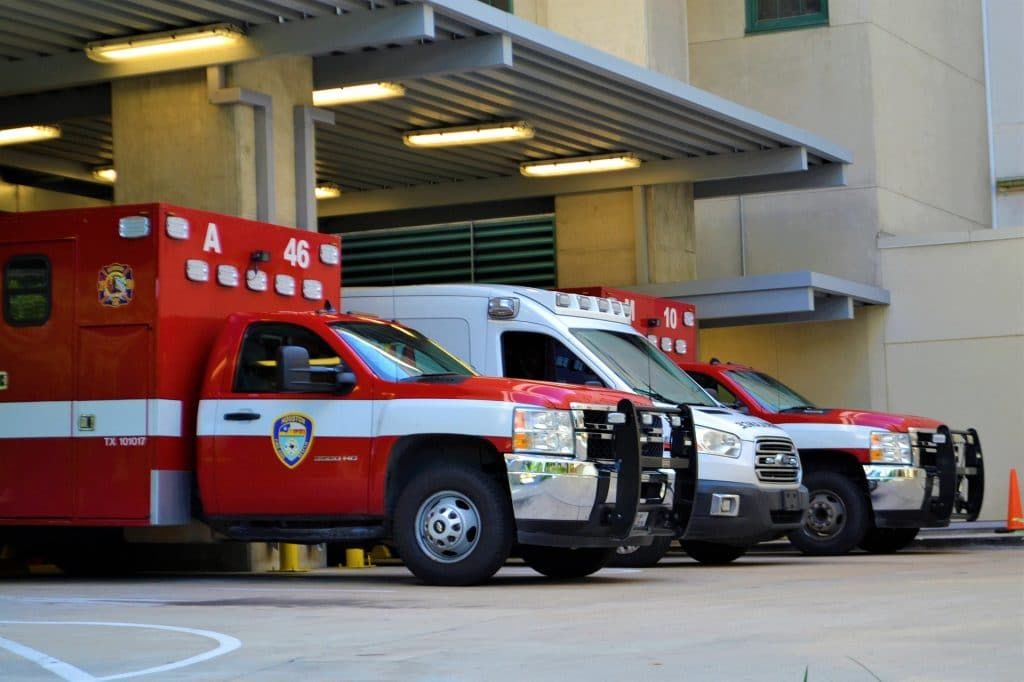If the coronavirus outbreak grows, can a strained US health care system keep up?
By Saskia Popescu | February 12, 2020
 Would the public health system in the United States be able to handle a greater outbreak of coronavirus infections? Ambulances wait outside of an emergency room. Credit: F. Muhammad/Pixabay.
Would the public health system in the United States be able to handle a greater outbreak of coronavirus infections? Ambulances wait outside of an emergency room. Credit: F. Muhammad/Pixabay.
China is taking dramatic measures to halt the spread of a new coronavirus that has already infected more than 42,000 people and killed more than 1,000 there. The country built two new hospitals in just over a week. With 2,600 beds between them, they represent an impressive feat of engineering meant to take some burden off the health care network in Hubei province, the epicenter of the outbreak. Meanwhile, the United States, with only a handful of confirmed cases of the disease, has strained to respond, raising concerns about how prepared the country’s health care system is, should the number infections begin to swell.
In the United States, the Centers for Disease Control and Prevention is reporting only 13 confirmed cases of the virus, formally known as COVID-19. Even so, for frontline health care workers, this is a challenging time. They’re having to manage the surge of people checking into doctor’s offices, including people with signs of infection who have also travelled to coronavirus hotspots as well as the worried-well. On top of that, they’re struggling to ensure their facilities have the right medical supplies. Despite the low risk of infection in the United States, there’s been an unfortunate run on protective equipment like masks that health care workers will need to treat patients with the new coronavirus. Moreover, a new study from Wuhan, China, suggests that many hospitalized patients are likely to require lengthy stays in hospital intensive care units, where workers will need even more supplies to treat them. That’s worrisome, as a significant number of patients in the study appeared to be getting infected in the hospital itself.
Not only is demand for personal protective equipment soaring, but the supply rests on a precarious reality. Some 95 percent of surgical masks and 70 percent of pathogen-filtering N95 masks used in the United States are manufactured abroad. As public health journalist Maryn McKenna notes, “That leaves the mask supply vulnerable to labor disruption if a pandemic sickens manufacturing workers, as well as to flat-out diversion if a government decides to keep its own stock at home.” Stockpiles of personal protective equipment are being depleted, although manufacturers have announced they will ramp up production. Tedros Adhanom Ghebreyesus, the director-general of the World Health Organization, spoke out about a demand that is now 100 times higher than normal, decrying the “widespread, inappropriate use of PPE outside of patient care.”
For hospital officials, preparing for cases of coronavirus infection means not only ensuring they have adequate supplies, but also the right processes put in place for the rapid identification and isolation of potential patients—which can be challenging during a patient surge.
Given the stresses facing hospitals and the frontline health care workers in them, a new study delivered unfortunate news last week. An article in the Journal of the American Medical Association that discussed the clinical characteristics of 138 hospitalized coronavirus patients in Wuhan included two deeply worrisome findings. First, 26 percent of those 138 patients required admission into an intensive care unit, a highly resource intensive level of treatment, both in terms of personnel and supplies. These are the patients most likely to require mechanical ventilation, invasive medical devices, and more. Patients who require intensive care have longer overall stays in the hospital. The study also found about 41 percent of cases were due to people getting infected as a result of being exposed in the hospital. This red-flag indicates that there have been breakdowns in infection prevention measures, whether those have to do with personal protective equipment or proper isolation procedures.
Well, this is good timing. https://t.co/H4WJWi6ors
— Maryn McKenna (@marynmck) February 10, 2020
Had a very concerning chat with a hospital exec recently about preparedness for nCoV.
US hospitals nowhere near ready for conditions like we're seeing in China. Neither are those in the developing world.
If anything, this NYT report may be too rosy.https://t.co/TqllwoURBe
— Jeremy Konyndyk (@JeremyKonyndyk) February 10, 2020
As previous coronavirus scares—including an outbreak of Middle East Respiratory Syndrome, or MERS, in South Korea, which began with a traveler returning from Saudi Arabia—have shown, hospitals can easily amplify a disease during outbreaks. And it’s clear that US hospitals and the US public health system as a whole are at a challenging crossroads. Will the United States see widespread transmission of the new coronavirus or just a few isolated cases? Either way, this coronavirus outbreak has already clearly shown that the United States needs to truly strengthen its critical biopreparedness infrastructure. The country is instead dismantling a tiered hospital system for dealing with serious infectious diseases like Ebola that are designated as special pathogens. While the coronavirus is not considered a special pathogen, overall the federal government’s message is clear: There’s little being done to encourage hospital leadership to invest in preparedness efforts.
Furthermore, President Trump actually proposed slashing funding for the Department of Health and Human Services in his most recent budget. The Centers for Disease Control and Prevention’s Public Health Preparedness and Response program would lose $25 million and the Office of the Assistant Secretary for Preparedness and Response’s Hospital Preparedness Program would lose $18 million. The Hospital Preparedness Program, for instance, provides funding for regional treatment centers for Ebola and other special pathogens, grants and funding for hospitals to enhance readiness, and tools for hospitals to prepare for patient surges.
To date, preparedness for infectious disease events just haven’t seemed to be a priority in the Trump administration. Maybe the coronavirus crisis will change that.
Together, we make the world safer.
The Bulletin elevates expert voices above the noise. But as an independent nonprofit organization, our operations depend on the support of readers like you. Help us continue to deliver quality journalism that holds leaders accountable. Your support of our work at any level is important. In return, we promise our coverage will be understandable, influential, vigilant, solution-oriented, and fair-minded. Together we can make a difference.
Keywords: COVID-19, Coronavirus, Department of Health and Human Services, Donald Trump, Tedros Adhanom Ghebreyesus, outbreak
Topics: Biosecurity














